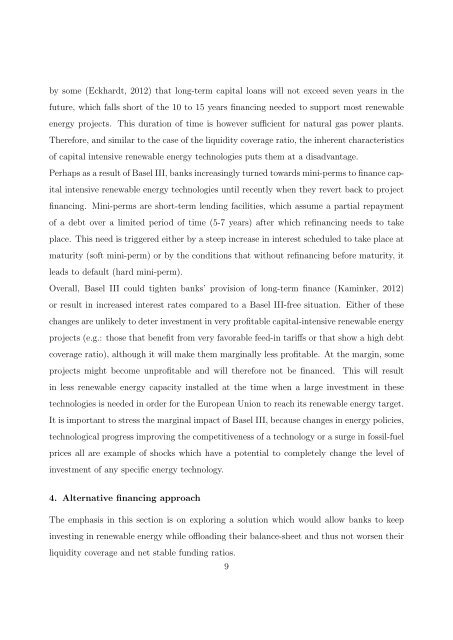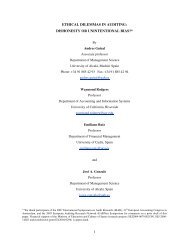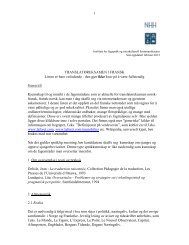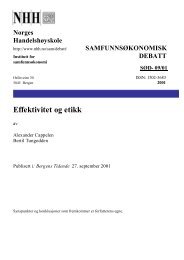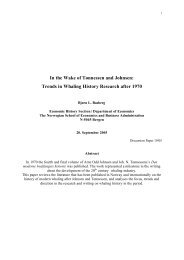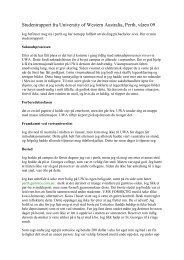The likely impact of Basel III on a bank's appetite for ... - NHH
The likely impact of Basel III on a bank's appetite for ... - NHH
The likely impact of Basel III on a bank's appetite for ... - NHH
Create successful ePaper yourself
Turn your PDF publications into a flip-book with our unique Google optimized e-Paper software.
y some (Eckhardt, 2012) that l<strong>on</strong>g-term capital loans will not exceed seven years in thefuture, which falls short <str<strong>on</strong>g>of</str<strong>on</strong>g> the 10 to 15 years financing needed to support most renewableenergy projects. This durati<strong>on</strong> <str<strong>on</strong>g>of</str<strong>on</strong>g> time is however sufficient <strong>for</strong> natural gas power plants.<str<strong>on</strong>g>The</str<strong>on</strong>g>re<strong>for</strong>e, and similar to the case <str<strong>on</strong>g>of</str<strong>on</strong>g> the liquidity coverage ratio, the inherent characteristics<str<strong>on</strong>g>of</str<strong>on</strong>g> capital intensive renewable energy technologies puts them at a disadvantage.Perhaps as a result <str<strong>on</strong>g>of</str<strong>on</strong>g> <str<strong>on</strong>g>Basel</str<strong>on</strong>g> <str<strong>on</strong>g>III</str<strong>on</strong>g>, banks increasingly turned towards mini-perms to finance capitalintensive renewable energy technologies until recently when they revert back to projectfinancing. Mini-perms are short-term lending facilities, which assume a partial repayment<str<strong>on</strong>g>of</str<strong>on</strong>g> a debt over a limited period <str<strong>on</strong>g>of</str<strong>on</strong>g> time (5-7 years) after which refinancing needs to takeplace. This need is triggered either by a steep increase in interest scheduled to take place atmaturity (s<str<strong>on</strong>g>of</str<strong>on</strong>g>t mini-perm) or by the c<strong>on</strong>diti<strong>on</strong>s that without refinancing be<strong>for</strong>e maturity, itleads to default (hard mini-perm).Overall, <str<strong>on</strong>g>Basel</str<strong>on</strong>g> <str<strong>on</strong>g>III</str<strong>on</strong>g> could tighten banks’ provisi<strong>on</strong> <str<strong>on</strong>g>of</str<strong>on</strong>g> l<strong>on</strong>g-term finance (Kaminker, 2012)or result in increased interest rates compared to a <str<strong>on</strong>g>Basel</str<strong>on</strong>g> <str<strong>on</strong>g>III</str<strong>on</strong>g>-free situati<strong>on</strong>. Either <str<strong>on</strong>g>of</str<strong>on</strong>g> thesechanges are un<str<strong>on</strong>g>likely</str<strong>on</strong>g> to deter investment in very pr<str<strong>on</strong>g>of</str<strong>on</strong>g>itable capital-intensive renewable energyprojects (e.g.: those that benefit from very favorable feed-in tariffs or that show a high debtcoverage ratio), although it will make them marginally less pr<str<strong>on</strong>g>of</str<strong>on</strong>g>itable. At the margin, someprojects might become unpr<str<strong>on</strong>g>of</str<strong>on</strong>g>itable and will there<strong>for</strong>e not be financed.This will resultin less renewable energy capacity installed at the time when a large investment in thesetechnologies is needed in order <strong>for</strong> the European Uni<strong>on</strong> to reach its renewable energy target.It is important to stress the marginal <str<strong>on</strong>g>impact</str<strong>on</strong>g> <str<strong>on</strong>g>of</str<strong>on</strong>g> <str<strong>on</strong>g>Basel</str<strong>on</strong>g> <str<strong>on</strong>g>III</str<strong>on</strong>g>, because changes in energy policies,technological progress improving the competitiveness <str<strong>on</strong>g>of</str<strong>on</strong>g> a technology or a surge in fossil-fuelprices all are example <str<strong>on</strong>g>of</str<strong>on</strong>g> shocks which have a potential to completely change the level <str<strong>on</strong>g>of</str<strong>on</strong>g>investment <str<strong>on</strong>g>of</str<strong>on</strong>g> any specific energy technology.4. Alternative financing approach<str<strong>on</strong>g>The</str<strong>on</strong>g> emphasis in this secti<strong>on</strong> is <strong>on</strong> exploring a soluti<strong>on</strong> which would allow banks to keepinvesting in renewable energy while <str<strong>on</strong>g>of</str<strong>on</strong>g>floading their balance-sheet and thus not worsen theirliquidity coverage and net stable funding ratios.9


